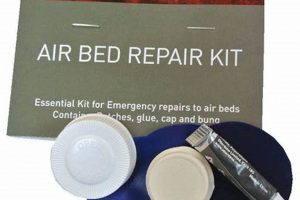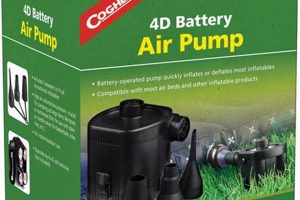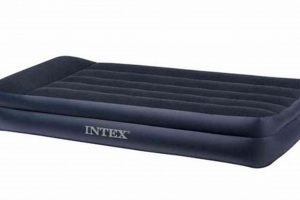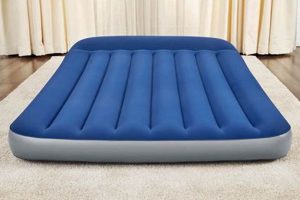A collection of items designed to mend punctures or tears in inflatable sleeping surfaces made of polyvinyl chloride. These typically include patches, adhesive, and an applicator or surface preparation tool. A common example would be a small box containing several clear, self-adhesive pieces and a small tube of specialized glue.
The value of such a set lies in its capacity to extend the lifespan of an otherwise compromised inflatable. Repairing damage prevents air leakage, preserving the comfort and utility of the mattress. Historically, makeshift methods were employed, but modern kits offer a more reliable and convenient solution, reducing waste and saving costs associated with replacement.
The following sections will delve into the components of these sets, the proper techniques for utilizing them, and considerations for selecting the appropriate product based on the specific damage and material characteristics of the inflatable being repaired. Understanding these aspects ensures effective and durable mending.
Vinyl Air Mattress Repair Kit
Effective utilization of a vinyl air mattress repair set ensures a lasting and reliable mend. Adherence to the following guidelines optimizes the repair process and prolongs the lifespan of the mattress.
Tip 1: Thoroughly clean the area surrounding the puncture. Employ a mild detergent and water, followed by complete drying. This removes contaminants that impede adhesive bonding.
Tip 2: Deflate the mattress completely before commencing the repair. Residual air pressure can compromise the patch’s adhesion and the overall integrity of the repair.
Tip 3: Roughen the surface of the vinyl around the puncture lightly with fine-grit sandpaper. This creates a textured surface that enhances the mechanical bond between the patch and the mattress.
Tip 4: Apply the adhesive sparingly and evenly to both the patch and the prepared area on the mattress. Excessive adhesive can weaken the bond and create a messy, uneven repair.
Tip 5: Allow the adhesive to become tacky before applying the patch. Refer to the adhesive manufacturer’s instructions for the appropriate drying time, typically a few minutes.
Tip 6: Apply firm, even pressure to the patch for several minutes to ensure proper adhesion. Use a smooth, hard object, such as a roller or the back of a spoon, to eliminate air bubbles.
Tip 7: Allow the repaired area to cure for the recommended time, usually 24 hours, before reinflating the mattress. Premature inflation can disrupt the bond and lead to failure.
Tip 8: When using self-adhesive patches, ensure the surface is completely dry and free of debris before application. Apply direct pressure for several minutes for optimal seal. Consider adding a weight on the patched area during curing for stronger adhesion.
Following these tips optimizes the effectiveness of a repair product, ensuring a durable seal and extending the usable life of the inflatable. Proper preparation and application techniques are essential for achieving lasting results.
The subsequent section will address the selection criteria for a suitable repair, focusing on material compatibility and the severity of the damage.
1. Adhesive Strength
Adhesive strength is a critical determinant of a successful repair when using a vinyl air mattress repair kit. The bond created by the adhesive must withstand the internal pressure exerted upon inflation, as well as the stresses induced by movement and weight distribution. Inadequate adhesive strength leads to patch detachment, resulting in air leakage and rendering the repair ineffective. The direct consequence of using an adhesive with insufficient strength is a compromised or failed repair, negating the effort invested in the patching process.
The type of adhesive included in the kit directly influences its performance. Vinyl-specific adhesives, often based on cyanoacrylate or specialized PVC bonding agents, are engineered to create a strong, flexible, and durable bond with the mattress material. General-purpose adhesives are typically inadequate, lacking the necessary chemical compatibility and shear strength to maintain the repair under duress. For example, a repair utilizing a high-quality PVC adhesive can sustain significantly higher internal pressures and withstand greater deformation compared to one made with a generic craft glue.
In conclusion, the adhesive strength within a set is paramount to its functionality. Understanding the characteristics and limitations of the adhesive is essential for achieving a lasting and reliable repair. Kits containing specialized, high-strength vinyl adhesives offer a substantially higher probability of success and extended performance compared to those with generic bonding agents. The selection of appropriate products directly impacts the longevity and utility of the repaired air mattress.
2. Patch Material
The efficacy of a vinyl air mattress repair hinges significantly on the characteristics of the material used for the patch. Selecting a compatible and durable patch is paramount to achieving a lasting seal and restoring the functionality of the inflatable.
- Material Compatibility
The patch material must be chemically compatible with the polyvinyl chloride (PVC) of the air mattress. Mismatched materials can result in poor adhesion, degradation of the patch or mattress material over time, and ultimately, a failed repair. For instance, a patch made of polyethylene would not bond effectively with a PVC mattress, leading to air leakage. Specialized PVC patches are designed to create a strong, lasting bond with the mattress material.
- Flexibility and Elasticity
Air mattresses undergo deformation during use due to weight distribution and pressure changes. The patch material should possess sufficient flexibility and elasticity to accommodate these movements without cracking or detaching. A rigid patch applied to a flexible mattress will likely fail due to stress concentration at the edges of the patch. Ideally, the patch should exhibit similar elastic properties to the original mattress material.
- Thickness and Durability
The thickness of the patch material influences its resistance to abrasion, punctures, and tears. A thicker patch offers greater protection against further damage and can withstand higher internal pressures. However, excessive thickness can reduce flexibility and create an uneven surface. Durability is also affected by the material’s resistance to UV radiation, temperature fluctuations, and chemical exposure. High-quality patch material maintains its integrity over time, ensuring a lasting repair.
- Adhesive Properties
The patch material’s surface characteristics directly impact its ability
to bond with adhesives. A smooth, non-porous surface may require surface preparation, such as roughening with sandpaper, to enhance adhesion. Certain patch materials are pre-treated with an adhesive-promoting layer to improve bond strength. The selection of a patch material with compatible adhesive properties is crucial for achieving a reliable and long-lasting repair.
The selection of appropriate patch material is integral to the long-term success of any vinyl air mattress repair endeavor. Consideration of material compatibility, flexibility, durability, and adhesive properties significantly enhances the likelihood of achieving a robust and reliable seal, thereby extending the usable lifespan of the mattress. Using correct kit with patch and glue material are important to get the right result and durable fix.
3. Surface preparation
Surface preparation constitutes a critical preliminary stage in the effective utilization of a vinyl air mattress repair kit. Contaminants such as dirt, oils, and moisture on the surface of the mattress impede the adhesive’s ability to form a strong, lasting bond with the patch. Inadequate preparation frequently leads to premature patch detachment, negating the purpose of the repair attempt. For instance, attempting to apply a patch to a dirty or greasy surface will result in a weak bond, prone to failure under the stress of inflation and use. The inclusion of cleaning wipes or instructions detailing proper surface cleaning within the kit underscores the significance of this step.
The process of surface preparation extends beyond simple cleaning. Roughening the surface with fine-grit sandpaper, often included in comprehensive kits or recommended in the instructions, creates microscopic irregularities. These irregularities increase the surface area available for adhesive bonding, promoting a stronger mechanical interlock between the patch and the mattress. Similarly, specialized primers, occasionally found in advanced kits, enhance adhesion by chemically modifying the surface to promote bonding. A real-world example involves a repair on a frequently used air mattress, where thorough cleaning and roughening extended the patch lifespan from days to months compared to a simple wipe-down.
In conclusion, surface preparation is not merely a procedural step but an integral determinant of repair success. Its omission or inadequate execution significantly reduces the likelihood of a durable repair. Understanding the principles of surface science, adhesion, and material compatibility informs best practices in surface preparation, maximizing the potential of a vinyl air mattress repair kit and extending the functional life of the inflatable. Proper surface preparation is the key to longevity of repair.
4. Application Method
The success of any repair using a vinyl air mattress repair kit hinges significantly on the application method employed. The technique used to apply the patch and adhesive directly influences the strength and longevity of the resulting seal.
- Surface Alignment and Patch Placement
Proper alignment of the patch over the damaged area is critical. Misalignment can create stress points, leading to premature failure. Ensuring the patch completely covers the puncture or tear, with sufficient overlap onto undamaged material, provides a secure foundation for the adhesive bond. An example is a small pinhole leak; the patch must extend at least an inch beyond the hole’s perimeter to distribute stress evenly. Without this overlap, the inflated mattress will concentrate force on the edge of the patch, quickly compromising the adhesive seal.
- Adhesive Application Technique
The even distribution of adhesive is essential for maximizing bond strength. Applying too little adhesive creates weak points, while excessive adhesive can weaken the bond and create a messy, uneven repair. The ideal application involves a thin, uniform layer covering both the patch and the prepared surface on the mattress. For instance, if using a liquid adhesive, it should be spread with a small brush or applicator, ensuring no areas are missed and that there are no excessive pools of glue.
- Pressure Application and Bubble Removal
After applying the patch, consistent and firm pressure must be applied to ensure complete contact between the adhesive and the vinyl surface. This pressure eliminates air bubbles that can weaken the bond. Rolling the patch with a smooth, hard object, such as a seam roller or even the back of a spoon, helps to achieve uniform pressure and expel trapped air. Failure to remove air bubbles results in voids in the adhesive layer, significantly reducing the overall strength of the repair.
- Curing Environment Control
The environment in which the repair cures also impacts its success. Extremes of temperature or humidity can negatively affect the adhesive’s curing process. A controlled environment, typically at room temperature and moderate humidity, allows the adhesive to fully cure and achieve its maximum bond strength. For instance, performing a repair outdoors in direct sunlight on a hot day can cause the adhesive to dry too quickly, resulting in a brittle and weak bond.
These elements underscore the importance of correct application techniques. Adhering to manufacturer’s instructions and employing careful, deliberate methods significantly increases the likelihood of a successful, long-lasting repair when using a vinyl air mattress repair kit. A poorly applied patch, regardless of the kit’s quality, will invariably fail.
5. Curing time
Curing time represents a critical, yet often overlooked, element in the successful utilization of a vinyl air mattress repair kit. This period, specified by the adhesive manufacturer, dictates the duration required for the bonding agent to achieve its maximum strength and establish a durable seal between the patch and the mattress. Shortening or circumventing the recommended curing time invariably compromises the integrity of the repair, leading to premature failure and air leakage. The adhesive’s chemical processes necessitate sufficient time to cross-link and form a robust molecular network, thereby resisting the internal pressure exerted upon inflation.
Consider, for instance, a scenario where an individual applies a patch to a punctured air mattress and, impatient to use the mattress, inflates it after only an hour, despite the instructions mandating a 24-hour curing period. The adhesive, still in a partially cured state, lacks the tensile strength to withstand the stress. As a result, the patch detaches, either immediately or after a short period of use, rendering the entire repair effort futile. Conversely, adhering strictly to the prescribed curing time allows the adhesive to fully cure, resulting in a repair that can withstand considerable pressure and deformation, extending the lifespan of the air mattress. The appropriate curing time guarantees the patch has been installed properly.
In conclusion, the curing time is an indispensable factor in the overall effectiveness of a product designed to mend inflatable vinyl surfaces. Deviations from the recommended curing period introduce a significant
risk of repair failure, negating the time and resources invested. Understanding and respecting this requirement is essential for achieving a lasting and reliable repair, maximizing the value and longevity of the air mattress. Thus, strict adherence to curing time recommendations is paramount for ensuring the long-term effectiveness of any vinyl air mattress repair.
6. Durability under stress
The capacity of a repaired vinyl air mattress to withstand stress is a primary concern when utilizing a repair set. The ultimate effectiveness of the repair hinges on its ability to endure sustained pressure, repeated use, and environmental factors without compromising the integrity of the seal.
- Adhesive Bond Strength under Cyclic Loading
The adhesive must maintain its bond under repeated inflation and deflation cycles, as well as the shifting weight distribution experienced during use. A repair adhesive that weakens or fails under cyclic loading will lead to air leakage and eventual patch detachment. For example, a mattress used nightly will subject the repaired area to significantly more stress cycles than one used only occasionally, requiring a more robust adhesive.
- Patch Material Resistance to Puncture and Abrasion
The patch material must resist further punctures and abrasions to prevent re-occurrence of leaks. A thin or weak patch will be more susceptible to damage from sharp objects or rough surfaces, undermining the initial repair. A thicker, more durable patch material provides a greater degree of protection and prolongs the lifespan of the repair.
- Environmental Factors and Material Degradation
Exposure to environmental factors such as UV radiation, temperature fluctuations, and humidity can degrade the patch material and adhesive over time, reducing their ability to withstand stress. A repair performed with materials that are not resistant to these factors will likely fail prematurely. For instance, a mattress stored in direct sunlight will experience accelerated degradation of the patch and adhesive, compromising the repair’s long-term durability.
- Seam Integrity and Stress Distribution
The location of the repair relative to existing seams or areas of high stress concentration influences its durability. Repairs near seams are subjected to increased stress due to the inherent weakness of these areas. A repair in such a location requires careful attention to adhesive application and patch placement to distribute stress evenly and prevent premature failure. Reinforcing the repair with additional material may be necessary to ensure long-term durability in high-stress areas.
These considerations are paramount in evaluating the suitability of a product. A set that incorporates high-strength adhesives, durable patch materials, and provides clear instructions for proper application and environmental protection will offer a greater likelihood of a lasting and stress-resistant repair, ultimately extending the usable life of the vinyl air mattress.
Frequently Asked Questions
The following addresses common inquiries regarding the utilization and effectiveness of repair implements designed for inflatable polyvinyl chloride (PVC) sleeping surfaces. Understanding these points is essential for successful and durable repairs.
Question 1: Can any adhesive be used with a vinyl air mattress patch?
No. The adhesive must be specifically formulated for bonding with vinyl. General-purpose adhesives often lack the chemical compatibility and flexibility required to form a lasting seal under the stress of inflation and use. Incompatible adhesives can lead to premature patch detachment and air leakage.
Question 2: Is surface preparation truly necessary before applying a patch?
Yes. Thorough cleaning and, in some cases, light abrasion of the area surrounding the puncture are critical. Contaminants such as dirt, oils, and moisture impede adhesive bonding. Roughening the surface increases the surface area available for adhesion, promoting a stronger, more durable seal.
Question 3: How long should the adhesive be allowed to cure before reinflating the mattress?
The curing time varies depending on the adhesive formulation and environmental conditions. Adherence to the manufacturer’s recommendations is essential. Premature inflation can disrupt the adhesive bond and lead to repair failure. Typically, a curing period of 24 hours is recommended.
Question 4: Can a repair be performed on a seam or near a seam?
Repairs near seams are inherently more challenging due to the increased stress concentration in these areas. Success depends on careful patch placement, thorough adhesive application, and potentially, reinforcement of the repair with additional material. Consider consulting a professional for seam repairs.
Question 5: Is it possible to repair large tears or punctures effectively?
The suitability of repair depends on the size and location of the damage. Small punctures and tears are typically amenable to repair. However, large tears or damage in high-stress areas may compromise the structural integrity of the mattress and necessitate replacement.
Question 6: How should the repaired mattress be stored to prolong the life of the repair?
Store the mattress deflated, clean, and dry, away from direct sunlight and extreme temperatures. Avoid folding the mattress along the repaired area, as this can create stress points and weaken the bond. Proper storage minimizes degradation and extends the lifespan of the repair.
In summary, effective mending relies on correct materials, precise application, and adherence to recommended curing times. Proper evaluation of the damage and thoughtful execution of the repair significantly increase the likelihood of success.
The following segment will provide a comparative analysis of various repair options, highlighting the features and benefits of different product types.
In Summary
The preceding sections have explored the multifaceted nature of implements designed for mending polyvinyl chloride inflatable sleeping surfaces. From understanding the importance of adhesive compatibility and surface preparation to recognizing the nuances of curing time and stress resistance, the effectiveness of these sets hinges on diligent application and informed decision-making. The choice of product and adherence to best practices directly correlate with the longevity and utility of the repaired mattress.
Therefore, individuals facing damage to their inflatable sleeping surfaces should approach the selection and utilization of a “vinyl air mattress repair kit” with careful consideration. The information presented serves as a foundation for informed action, promoting resourcefulness and extending the life cycle of valuable possessions. Failure to address damage adequately may result in compromised comfort and the unnecessary discarding of otherwise functional items.







